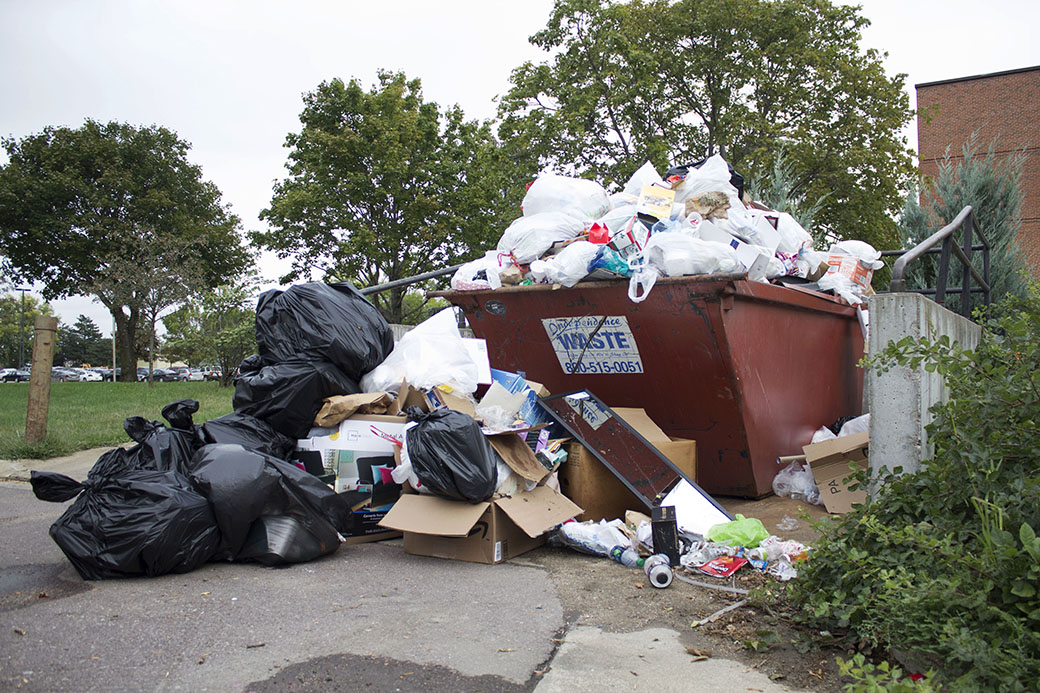
Pilot recycling program still in the works, behind schedule
A pilot recycling program aiming to make campus more sustainable is still in the works, months after a waste audit found that minimal recycling efforts were being made at USD.
The program is expected to be put into action by the end of the semester. Currently, the Muenster University Center is the only building with a USD-coordinated recycling program on campus.
According to Bob Iverson, the solid waste director in Vermillion, to date the university has brought 142,617 pounds of recycling to the Missouri Valley recycling center this year. In 2015 the recycling center received 163,650 pounds of waste from the university. Iverson said that on average 10,000-23,000 pounds of university waste are brought to the recycling center each month.
Last spring the President’s Committee on Sustainability hired the Verdis Group, an environmental consulting firm, to deliver an evaluation on USD’s sustainability program. Over the summer the committee has been evaluating the Verdis Groups’ recommendation.
Currently, the committee is waiting to hear back from facilities management on the logistical possibilities of a recycling program, according to Scott Pohlson, chair of the President’s Committee on Sustainability.
“It’s not where I wanted it to be at this point, but it’s not a huge set back. We are probably a month behind where I hoped to be,” Pohlson said. “Now we are waiting to see what does facilities management see as the pros and cons of the recommendation… I didn’t realize it would take this long. But where we’re at, truth be told, is facilities management needs more resources.”
Once the committee hears back from facilities management they will put a pilot recycling program into place in one building on campus.
“Everyone agrees we need a pilot program. The pilot program would be in one building,” Pohlson said. “What we have to figure out is the process around it. Do we take the recycling to Missouri River Valley or do they come get it? Do we have recycling containers on each floor? Or is it one container behind the building that everybody takes their stuff out to?”
The reason so much thought is being put into the process is because the Missouri Valley Recycling Center is a multi-stream system, which means all waste has to be sorted before it’s dropped off. If it were a single stream all waste could be put in the same container.
An easy fix the committee has looked at is having a common recycling area on each floor. However, Meghann Jarchow, a sustainability assistant professor and member of the President’s Committee on Sustainability, said this makes the process tricky because faculty and staff are so used to having a garbage can in their office.
“We found there are a lot of tiny garbage cans, like more than 2,000…What that means is that every custodial person has to go through every day and empty those out and usually they have to put a new garbage bag in every day,” Jarchow said. “Okay, well in any individual’s office the amount of waste you make in one day is small, the garbage bag is more than that. So A) it’s inefficient and B) it’s creating more waste.”
Jarchow herself has started asking her custodian not to empty her garbage everyday and has her own bin under her desk for recycling. She said she takes her food waste to a common area garbage and then is able to empty her office waste once a month and recycling every couple months.
“When the recycling is full I just take it and sort it out myself at the recycling bins,” Jarchow said. “It only takes me like 10 minutes.”
What Jarchow does in her office is similar to the pilot program the committee wants to implement.
In the pilot the committee is interested in, there would be common recycling areas on every floor of a building. This way staff and students could still have a garbage can in their rooms or offices but take their recycling and put it in the proper bin.
Pohlson said a program like this is easier for facilities management opposed to having to collect recycling from each person’s room or office.
According to Jarchow, however, faculty and staff aren’t as excited about common recycling areas.
“On that survey that got sent out one of the questions was, ‘Would you be willing to do that?’ and most faculty and staff said no,” she said.
One of the most important things to the committee is making sure they come up with a program facilities management can handle, according to Pohlson and Jarchow.
“They’re always hiring custodians. It is a very very hard position to fill,” Jarchow said. “We can not propose something that is undoable.”
Another obstacle USD faces when it comes to sustainability is that there is no “sustainability coordinator,” which most universities have. South Dakota State University hired a sustainability coordinator just this year.
“I think it is a limitation that this is not someone’s job and so everyone is doing extra. There are a lot of campuses that have a human or many humans to do the sustainability effort on campus,” Jarchow said. “So it is a key limitation of our ability to get things done, it’s just not reasonable to expect everyone to do extra work.”
While a sustainability coordinator would help on campus, the committee is not considering creating a position, according to Jarchow.
“Getting coordinated would help so much with getting things done.” she said.


